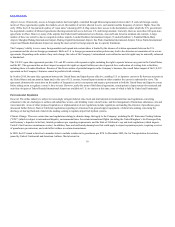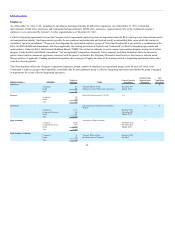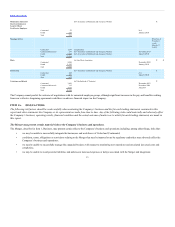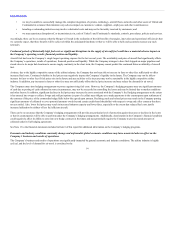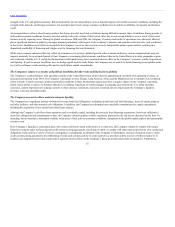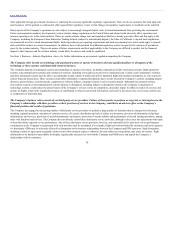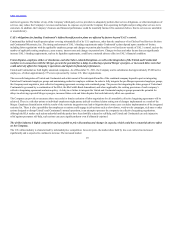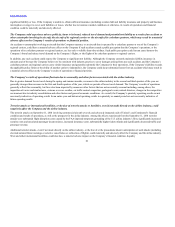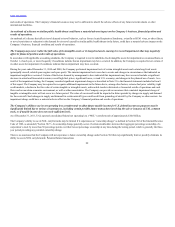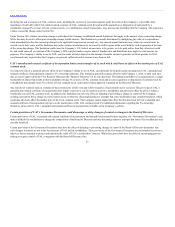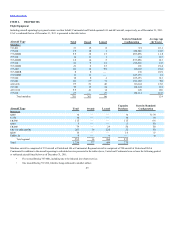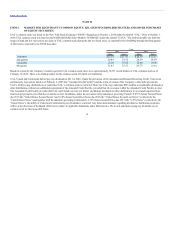United Airlines 2011 Annual Report Download - page 21
Download and view the complete annual report
Please find page 21 of the 2011 United Airlines annual report below. You can navigate through the pages in the report by either clicking on the pages listed below, or by using the keyword search tool below to find specific information within the annual report.
Table of Contents
presence of low-cost carriers, which engage in substantial price discounting, has diminished the ability of large network carriers to achieve sustained
profitability in domestic markets.
Airlines also compete for market share by increasing or decreasing their capacity, including route systems and the number of markets served. Several of the
Company’s domestic competitors have increased their international capacity by including service to some destinations that the Company currently serves,
causing overlap in destinations served and therefore increasing competition for those destinations. In addition, the Company and certain of its competitors have
implemented significant capacity reductions in recent years in response to the global recession. Further, certain of the Company’s competitors may not reduce
capacity or may increase capacity, thereby diminishing the expected benefit to the Company from capacity reductions. This increased competition in both
domestic and international markets may have a material adverse effect on the Company’s results of operations, financial condition or liquidity.
The airline industry may undergo further bankruptcy restructuring, industry consolidation, or the creation or modification of alliances or joint
ventures, any of which could have a material adverse effect on the Company.
The Company faces and may to continue to face strong competition from other carriers due to bankruptcy restructuring, industry consolidation, and the
creation and modification of alliances and joint ventures. A number of carriers have filed for bankruptcy protection in recent years and other domestic and
international carriers could restructure in bankruptcy or threaten to do so in the future to reduce their costs. Most recently, AMR Corporation, the parent
company of American Airlines, filed for Chapter 11 bankruptcy protection in November 2011. Carriers operating under bankruptcy protection can operate in
a manner that could be adverse to the Company and could emerge from bankruptcy as more vigorous competitors.
Both the U.S. and international airline industries have experienced consolidation through a number of mergers and acquisitions. The Company is also facing
stronger competition from expanded airline alliances and joint ventures. Carriers entering into and participating in airline alliances, slot swaps and/or joint
ventures may also become strong competitors as they are able to coordinate routes, pool revenues and costs, and enjoy other mutual benefits, achieving many
of the benefits of consolidation. “Open skies” agreements, including the agreements between the United States and the EU and between the United States and
Japan, may also give rise to additional consolidation or better integration opportunities among international carriers.
There is ongoing speculation that further airline industry consolidations or reorganizations could occur in the future. The Company routinely engages in
analysis and discussions regarding its own strategic position, including alliances, asset acquisitions and divestitures and may have future discussions with
other airlines regarding strategic activities. If other airlines participate in such activities, those airlines may significantly improve their cost structures or
revenue generation capabilities, thereby potentially making them stronger competitors of the Company and potentially impairing the Company’s ability to
realize expected benefits from its own strategic relationships.
Increases in insurance costs or reductions in insurance coverage may materially and adversely impact the Company’s results of operations and
financial condition.
Following the terrorist attacks on September 11, 2001, the Company’s insurance costs increased significantly and the availability of third-party war risk
(terrorism) insurance decreased significantly. The Company has obtained third-party war risk (terrorism) insurance through a special program administered
by the FAA. Should the government discontinue this coverage, obtaining comparable coverage from commercial underwriters could result in substantially
higher premiums and more restrictive terms, if such coverage is available at all. If the Company is unable to obtain adequate third-party war risk (terrorism)
insurance, its business could be materially and adversely affected.
If any of the Company’s aircraft were to be involved in an accident or if the Company’s property or operations were to be affected by a significant natural
catastrophe or other event, the Company could be exposed to
20


